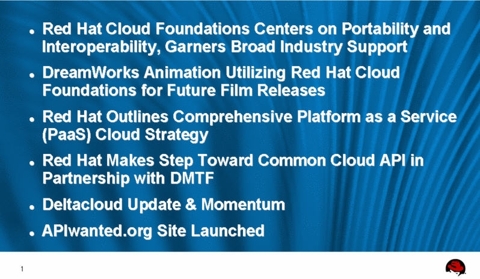Red Hat (RHT) on Wednesday took the wraps off its cloud computing strategy, which revolves around promoting interoperability and application portability.
In a nutshell, Red Hat’s cloud strategy includes platform-as-a-service, a JBoss middleware effort to allow open developer choice and moves aimed to put the company in the middle of cloud applications.
Paul Cormier, president of Red Hat’s products and technology business, said Red Hat is aiming to align all of its products with cloud computing. In Cormier’s view, there are only two companies that can provide a stack of cloud-enabled enterprise software—Red Hat and Microsoft.
The takeaway: Red Hat is positioning itself as the open source cloud provider and as an alternative to Microsoft’s Azure platform. The company touted a cloud computing win with Dreamworks Animation. Red Hat’s take: No customer should be locked into a cloud platform.
Red Hat executives said that companies will be increasingly managing hybrid cloud infrastructure. The company’s plan is to be in the middle of those hybrid environments (statement). It should be noted though that the cloud governance game that Red Hat is entering also includes a bevy of other players ranging from BMC Software to CA to Hewlett-Packard (HPQ) and IBM.
At a higher level, Red Hat is also aiming to box in virtualization rivals such as VMware (VMW) and Citrix (CTXS) as one-trick server ponies. Oracle also aimed to do something similar with its virtualization strategy. Among the key moving parts of Red Hat’s cloud plans:
- Red Hat’s platform-as-a-service (PaaS) strategy will revolve around the JBoss middleware. This offering will be designed to allow companies, cloud and software-as-a-service (SaaS) providers to build and deploy applications.
- JBoss will aim to be flexible to accommodate multiple development frameworks ranging from Java to Spring to Ruby and others.
- JBoss cloud images will be available
